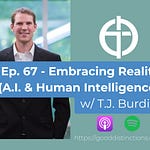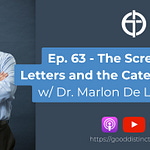The full written version of the episode can be found further below. Please, also, enjoy a short recording of the Regina Caeli chant by Will Wright at the beginning of the episode. Happy Easter!
Summary
In this episode, Will Wright discusses the historicity of the resurrection of Jesus Christ. He emphasizes the importance of understanding what it means for something to be historical and provides an overview of different historical periods. Wright then presents several proofs for the resurrection, including the empty tomb, post-resurrection appearances of Jesus, and the transformation of the disciples. He also highlights the significance of early Christian creeds and the continuity of belief in the resurrection throughout history. Wright concludes by emphasizing the need for faith and reason to work together in understanding the truth of the resurrection.
Takeaways
- The resurrection of Jesus Christ is a historical event supported by multiple proofs, including the empty tomb, post-resurrection appearances, and the transformation of the disciples.
- Early Christian creeds attest to the reality of the resurrection and demonstrate the continuity of belief throughout history.
- Understanding the historical context and the lack of alternative explanations further strengthens the evidence for the resurrection.
- Faith and reason are not in conflict but work together to support the truth of the resurrection.
Chapters:
00:00: Introduction and Podcast Promotion
01:38: Understanding History
03:40: Classical Period and Roman Historians
05:08: Medieval and Modern Periods
05:38: Historical Evidence for the New Testament
06:47: Reliability of the Gospels
09:00: Levels of Knowing
09:30: Proofs for the Resurrection: Empty Tomb
11:49: Proofs for the Resurrection: Post-Resurrection Appearances
12:55: Proofs for the Resurrection: Transformation of the Disciples
19:32: Proofs for the Resurrection: Historical Context
20:54: Conclusion and Importance of the Resurrection
23:13: Call to Action and Podcast Promotion
Full Written Transcript:
What is Historical?
Humanity has practiced stewardship and dominion over the Earth for many millennia. However, recorded History is relatively new. Five thousand or so years ago in Mesopotamia, we have archaeological evidence of cave paintings and other artifacts that indicate a culture of storytelling. Oral traditions were the primary means of the historical record in the prehistoric period. This is, of course, why we refer to that time as “prehistoric.”
In the Ancient Period, the record became more extensive and we started to see written content from Mesopotamia, Egypt, China, Mesoamerica, and the Indus Valley. The texts are legal documents, religious documents, poetry, and other items related to political, social, and cultural life.
In the Classical Period, the Greeks and Romans left a great deal of historical accounts, works of philosophy, legal writings, and works of literature. The historical record at this time is significant. One of the most famous Roman historians is Titus Livus, known as Livy. He was born around 60 B.C. and wrote during the transition from the Roman Republic to the Roman Empire. Over his life, he wrote an astounding 142 books. Today, however, we only have about 35 of these books.
The most famous Roman Historian during the time of Christ is Tacitus. He wrote two main works: “Histories” and “Annals.” Histories had 16 books, of which we only have 1 - 6 in their entirety and parts of books 11 - 16. Annals had either 12 or 14 books, of which we have 1 - 4 and parts of book 5. These partial volumes are essential historical sources and one of the most significant sources for understanding Roman history and politics.
In the Medieval Period, the historical record was preserved in chronicles, charters, religious texts, and legal records. And in the Modern Period, following the invention of the printing press, the historical record became abundant. In the age of the Internet, the amount of written and published material has increased at an exponential rate.
For the New Testament, the works are situated in the Classical Period, so we should apply the scrutiny appropriate to that period. There are multiple codices from the 4th and 5th Centuries which contain most of the Old and New Testaments in Greek, Latin, Hebrew, and Aramaic. These codices provide abundant historical evidence for the consistency of biblical writings. If there were major changes in the texts, then we would expect a codex in one location to be vastly different from a codex in another location, especially after four hundred years. Instead, we find that the extant copies of the manuscripts of the Bible are consistent, one to the other. And… and this should not be understated… we have them! We have far more manuscripts of Sacred Scripture than we do of Livy or Tacitus. And, yet, the historical reliability of the latter are rarely questioned by modern scholars.
The reality is that the Gospels, especially, are historically reliable. The Gospel writers were eyewitnesses who wrote shortly after the recorded events. The apostles followed Jesus and lived with Him for three years, receiving daily teachings. They lived in the Classical Period in which oral tradition was exceptionally important and when memorization skills were top notch. The apostles likely made written notes while traveling with Jesus, as well. Further, it is clear that the Gospel writers intended to write reliable history. And we can show that they did, in fact, write reliable history.
To learn more about the reality of the reliability of the Gospels, I highly recommend reading more at Catholic Answers on The Reliability of the Gospels by Karlo Broussard.
Three Levels of Knowing
I am not suggesting that the proofs of the Resurrection of Jesus that I am about to run through are “slam dunks.” What we are showing is akin to the Five Ways of St. Thomas Aquinas - they are converging and convincing arguments. I do not think that any one of these proofs will suffice to convert an atheist. However, the evidence is nonetheless historically formidable.
There are three levels of knowing and discussing the things of God. First, we have to answer the question: Does God exist? If yes, then we move to step two. Second, we answer: Is Jesus God? If yes, then we move to three. Third, we answer: Is the Catholic Church the Church that Jesus founded? And, of course, the answer is yes. What we are about to investigate presumes the existence of God and speaks to both the second and third level. The Resurrection shows us the Divinity of Jesus and its truth is demonstrated and handed down through the testimony of the Church.
Proofs of the Resurrection of Jesus
Now, onto the proof for the Resurrection of Jesus.
Empty Tomb
The unanimous testimony of the four Gospels (Matthew, Mark, Luke, and John) is that the tomb of Jesus was discovered as empty on the third day after the crucifixion. The tomb being empty is unexpected. Jesus was laid in the tomb on Friday because the Sabbath was quickly approaching. On the Sabbath, the Jewish people are forbidden from doing anything laborious. Removing the body of Jesus certainly would have constituted work. There is the possibility that Jesus' body was stolen, but this is unlikely as well. Those who put Jesus to death were concerned of theft because they did not want a martyred “ghost” to continue making trouble. They, therefore, set Roman guards at the entrance of the tomb to stop this from happening. No rabble would be able to overtake Roman soldiers without raising notice and possibly starting a war.
Post-Resurrection Appearances:
In the Gospels and Acts of the Apostles, Jesus appeared multiple times to different individuals and groups: the pair on the road to Emmaus, Mary Magdalene at the tomb, the apostles in the Upper Room, on the seashore, and then prior to the Ascension. He also appeared to the incredulous St. Thomas as well as to St. Paul on the road to Damascus. Most of the post-resurrection appearances are reported in the texts of early Christians and followers of Jesus; so, we have to be aware of bias and theological interpretation. Perhaps the appearances were a shared vision or spiritual experience rather than a physical resurrection. However, this does not explain the next proof: the utter transformative effect the Resurrection had on the disciples.
Transformation of the Disciples
Before the crucifixion the apostles, with the exception of St. John, were huddled in fear in the Upper Room. After the Resurrection, multiple encounters with the Risen Jesus, the Ascension, and Pentecost, the disciples were transformed. Proclamations became bold and tenacious rather than fearful and disillusioned. The willingness to endure persecution and martyrdom can be partly explained by the reality of the Resurrection. The transformation and testimony of St. Paul is particularly prominent because he persecuted Christians and put them to death prior to His encounter with the Risen Christ. Many who are critical of this line of thinking will say that there are other psychological or sociological factors that could explain the change of behavior and belief. However, I cannot imagine that these factors would explain the persistence of the early Church in their conviction in the face of persecution and martyrdom. All but one of the apostles, in traditional understanding, died as martyrs. You do not die for some spiritual experience, some after isolation and torture. You die for the Risen Christ who is truly risen.
Early Christian Creeds
The early Christian creeds attest to the Resurrection, including the writing of St. Paul to the Church in Corinth:
3 For I delivered to you as of first importance what I also received: that Christ died for our sins in accordance with the Scriptures, 4 that he was buried, that he was raised on the third day in accordance with the Scriptures, 5 and that he appeared to Cephas, then to the twelve. 6 Then he appeared to more than five hundred brothers at one time, most of whom are still alive, though some have fallen asleep. 7 Then he appeared to James, then to all the apostles. 8 Last of all, as to one untimely born, he appeared also to me. (1 Cor. 15:3-8)
Of course the Apostles’ Creed attests the Resurrection, as does the Athanasian Creed and the later Niceno-Constantinopolitan Creed. These creeds remind us that the historical reality of the Resurrection is paramount to the veracity of Catholicism. If we found the bones of Jesus, we would rightly leave the Faith entirely.
Critics of this view will say that these creeds do not prove the Resurrection, they only prove that the early Church believed in the Resurrection. Fair enough. But this is only one aspect of the proofs for the Resurrection.
Historical Context
At the time, the concept of bodily resurrection was not part of Jewish thought. So, hearing that Jesus had risen from the dead, the Romans could simply produce Jesus’ body to quell any rumors amongst the early Christians. Again, the tomb was guarded by a Roman guard, which would not be easily and quietly overtaken.
Continuity with Christian Tradition
The Resurrection as a real, historical event has been held by Christians from the apostles until now. Evidence of the reality of the Resurrection is thus further strengthened by consistent tradition. Tradition is not direct evidence of the Resurrection itself, but it does show a persistence in the belief.
The Resurrection of Jesus is a True Event
When weighed individually, each of these proofs can be dismissed. But when taken together, the preponderance is more powerful. The reality is that the Resurrection of Jesus Christ is a true event. Ultimately, this evidence does not prove beyond the shadow of a doubt that Jesus rose from the dead. If it was, then our free will would be overtaken.
God always reveals Himself to those who seek and promises answers to those who question. But for those who do not seek, then they will not find. For those who do not ask questions, they will receive no answers. The evidence that God does give us is overwhelming - for Himself, for the divinity of Jesus, for the truth of the Church, and, yes, for the bodily Resurrection of Jesus Christ on the third day.
Happy Easter! Christ is Risen! Indeed, He is Risen!










